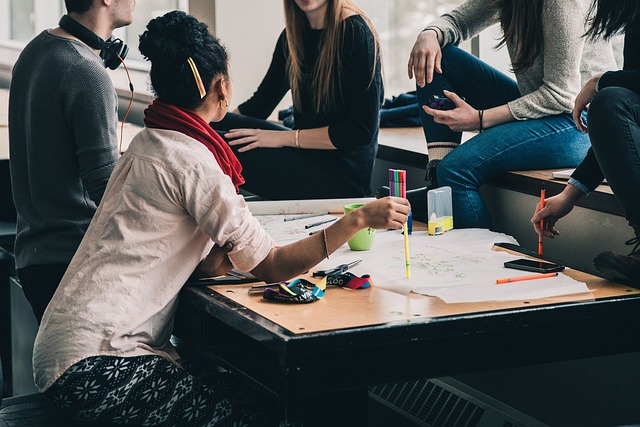Brainstorming sessions are often hailed as the breeding ground for creativity and innovation, where ingenious ideas emerge out of collaborative thinking. However, there’s more to these sessions than mere random discussions. In order for brainstorming to be truly successful, there are crucial factors that need to be considered. Whether you’re leading a team or working independently, understanding these essential elements and incorporating them into your brainstorming process can elevate your results to new heights. So, let’s dive into the fundamental factors that will unlock the true power of brainstorming, unleashing your mind’s full potential.
Contents
- 1. The Importance of Preparation: Setting the Stage for a Successful Brainstorming Session
- 2. Cultivating a Positive and Inclusive Environment: Essential for Encouraging Unrestricted Idea Generation
- 3. Embracing Diverse Perspectives: Leveraging Differences to Foster Creative Solutions
- 4. Harnessing the Power of Brainstorming Techniques: Tools and Approaches to Boost Productivity
- 5. Balancing Structure and Spontaneity: Striking the Right Mix for Effective Brainstorming Sessions
- 6. Supporting Active Participation: Techniques to Engage Introverts and Enhance Collaboration
- 7. Overcoming Brainstorming Challenges: Strategies to Manage Group Dynamics and Avoid Common Pitfalls
- 8. Deliberating, Selecting, and Implementing Ideas: Maximizing the Outcome of Brainstorming Sessions
- 1. Foster a Collaborative Environment
- 2. Embrace Idea Evaluation
- Frequently Asked Questions
- In Retrospect
1. The Importance of Preparation: Setting the Stage for a Successful Brainstorming Session
Effective brainstorming sessions can be the catalyst for groundbreaking ideas, problem-solving, and creativity. However, without proper preparation, these sessions may fall flat and fail to produce the desired outcomes. By setting the stage for a successful brainstorming session, you can maximize participation, encourage collaboration, and ultimately boost the chances of generating innovative solutions.
Creating a conducive environment: To foster a productive brainstorming session, it is crucial to ensure that the physical environment is comfortable and conducive to creativity. Consider factors such as adequate lighting, comfortable seating arrangements, and minimal distractions. Provide a variety of materials such as whiteboards, post-it notes, markers, and flip charts, allowing participants to freely express their thoughts and ideas. Additionally, consider using visual aids or interactive displays to stimulate imagination and encourage active participation.
- Define clear objectives and goals: Clearly communicate to all participants the purpose and objectives of the brainstorming session. This helps set the right expectations and ensures everyone is on the same page. Make the goals specific and measurable so that progress can be tracked throughout the session.
- Prepare relevant materials: Before the session, gather and organize any materials that may be beneficial to the brainstorming process. This might include background information, research findings, previous project outcomes, or customer insights. Having these materials readily available can spark inspiration, provide context, and help participants generate informed ideas.
- Invite the right mix of participants: Carefully consider who should participate in the brainstorming session. Including individuals from diverse backgrounds, departments, and levels in the organization can bring fresh perspectives and increase the likelihood of varied ideas. It is important to select participants who are open-minded, creative, and eager to contribute to the collaborative process.
2. Cultivating a Positive and Inclusive Environment: Essential for Encouraging Unrestricted Idea Generation
In order to foster an environment that encourages unrestricted idea generation, it is crucial to cultivate a positive and inclusive atmosphere. Creating such an atmosphere not only promotes diversity and equality, but also boosts creativity and innovation within teams. Here are some key strategies to consider:
- Embrace diversity: Value the unique perspectives and experiences of each individual on your team. Encourage diversity in nationality, gender, age, and background. Remember that different viewpoints can lead to more comprehensive and groundbreaking ideas.
- Promote open communication: Establish a culture where everyone feels comfortable expressing their thoughts and opinions. Encourage active listening, allowing all team members to contribute without fear of judgment. Inclusive communication breeds trust and sparks unrestricted idea generation.
- Provide equal opportunities: Ensure fairness and equal access to resources, opportunities, and recognition. Avoid favoritism or bias, and create a level playing field for all team members. Emphasize the value that each individual brings to the table, regardless of their role or position.
Moreover, it is vital to foster a supportive and collaborative environment, where individuals feel empowered to freely share their ideas. Here are a few additional approaches to consider:
- Celebrate successes: Recognize and reward individuals who contribute innovative ideas or solutions to problems. Publicly acknowledging achievements not only boosts morale but also encourages others to share their own ideas.
- Encourage risk-taking: Create a culture that embraces calculated risks and views failure as an opportunity for growth. Encouraging experimentation helps employees overcome the fear of failure, ultimately leading to more courageous and unrestricted idea generation.
- Create spaces for dialogue: Establish platforms for brainstorming, such as regular team meetings or virtual collaboration spaces. Allow for open discussions, where team members can bounce ideas off each other, challenge assumptions, and build upon existing concepts.
3. Embracing Diverse Perspectives: Leveraging Differences to Foster Creative Solutions
When it comes to problem-solving and innovation, diversity plays a critical role in unlocking new possibilities. By embracing diverse perspectives, we can tap into a vast array of experiences, backgrounds, and ideas that contribute to the creation of truly creative solutions. Here are some key ways in which we can leverage our differences to foster innovation:
- Encouraging open dialogue: Creating an environment where everyone feels comfortable expressing their opinions and ideas is essential. By encouraging open dialogue, we allow diverse perspectives to be heard and foster collaboration among individuals with different viewpoints.
- Promoting inclusion: Inclusion is not just about having diverse voices at the table but ensuring that they are actively engaged and empowered. By promoting inclusion, we create a culture where individuals feel valued and respected, leading to increased creativity and innovation.
- Embracing cognitive diversity: Cognitive diversity refers to the differences in how people think, problem-solve, and approach challenges. By embracing cognitive diversity, we can capitalize on various thinking styles and leverage different strengths, resulting in more robust and innovative solutions.
By embracing diverse perspectives, we tap into the collective knowledge and creativity of our teams, breaking free from conventional thinking and exploring uncharted territories. It is through this collaboration and the strength of our differences that we can truly foster groundbreaking and inventive solutions.
4. Harnessing the Power of Brainstorming Techniques: Tools and Approaches to Boost Productivity
Brainstorming is a powerful technique that can significantly enhance productivity and foster creativity within teams. By employing various tools and approaches, you can effectively harness the power of brainstorming and unlock the full potential of your team’s collective intelligence.
One essential tool for successful brainstorming is the use of technology. Online collaboration platforms and brainstorming software provide a virtual space where team members can brainstorm ideas, add comments, and collaborate in real-time, regardless of their physical location. This not only eliminates the limitations of time and distance but also ensures that all ideas are captured and easily accessible for future reference. Additionally, these tools often offer features like voting or prioritization, allowing teams to streamline their ideas and focus on the most promising ones.
Another approach to boost productivity during brainstorming sessions is to establish a positive and inclusive environment. Encourage open-mindedness, active participation, and the belief that every idea is valuable. To achieve this, establish some ground rules, such as no judgment or criticism during the initial brainstorming phase, and emphasize the importance of listening to each team member’s contributions. Utilizing techniques like “brainwriting” or “silent brainstorming” can also be effective in ensuring that every individual has an equal opportunity to voice their ideas without interruption or bias. By fostering a safe and supportive atmosphere, team members will feel more comfortable sharing their unique perspectives, leading to more diverse and innovative ideas.
Incorporating these brainstorming techniques and utilizing the right tools can boost productivity, enhance collaboration, and unlock the potential of your team. By creating an environment that encourages open-mindedness and utilizing technology to facilitate seamless collaboration, you can harness the power of brainstorming and inspire your team to achieve extraordinary results. So, let your team’s creative juices flow and watch as possibilities transform into reality.
5. Balancing Structure and Spontaneity: Striking the Right Mix for Effective Brainstorming Sessions
In order to have successful brainstorming sessions, finding the perfect balance between structure and spontaneity is crucial. While structure provides a framework for organization and keeps everyone focused, spontaneity encourages free-flowing ideas and promotes innovation. Here are some key tips to help you strike the right mix:
- Set clear objectives: Define the purpose and goals of the brainstorming session beforehand. This provides structure and ensures participants are aligned from the start.
- Encourage open communication: Create an inclusive environment where everyone feels comfortable sharing their ideas. Emphasize the importance of active listening and refrain from criticizing or judging contributions.
- Use timeboxing techniques: Allocate specific time limits for different phases of the brainstorming session. This helps maintain structure while allowing for spontaneous thinking within each time constraint.
While structure can guide the flow of a brainstorming session, injecting spontaneity is equally important. It allows participants to think outside the box and explore creative solutions. Here are a few strategies to embrace the spontaneity:
- Implement icebreaker activities: Start the session with a fun and engaging activity that encourages participants to let loose and generate ideas without feeling intimidated.
- Incorporate improvisation exercises: Use improv games to stimulate quick thinking and encourage participants to build upon each other’s ideas. This spontaneous approach can lead to unexpected breakthroughs.
- Embrace the power of “Yes, and…”: Encourage participants to build upon ideas by saying “Yes, and…” instead of rejecting or dismissing them. This fosters an environment of creative collaboration and prevents premature evaluation.
By finding the right balance between structure and spontaneity, you can unlock the full potential of brainstorming sessions. Remember, effective brainstorming requires both logical organization and a touch of imaginative freedom!
6. Supporting Active Participation: Techniques to Engage Introverts and Enhance Collaboration
When it comes to group collaborations, it’s important to create an environment that allows everyone to participate actively, including introverts. By understanding their unique needs and preferences, teams can harness the valuable contributions introverts bring to the table. Here, we explore techniques to engage introverts and enhance collaboration:
Create opportunities for reflection: Introverts often thrive in introspective moments. Encourage them to think deeply about the topic at hand and provide them with ample time to process their thoughts before participating. This can be done through:
- Providing pre-meeting agendas or materials for introverts to review in advance.
- Asking introverts to share their thoughts through written communication, such as email or chat platforms, before group discussions.
- Scheduling short breaks during meetings to allow introverts to gather their thoughts and recharge.
Foster small-group discussions: Large group settings can intimidate introverts, making it challenging for them to contribute. To promote their active participation, consider:
- Breaking into smaller groups during meetings to allow introverts to share their ideas and perspectives more comfortably.
- Designating a facilitator for each group to ensure everyone has an opportunity to speak, while also managing time constraints.
- Providing clear discussion prompts and focusing on specific areas of expertise to make it easier for introverts to participate.
7. Overcoming Brainstorming Challenges: Strategies to Manage Group Dynamics and Avoid Common Pitfalls
When it comes to brainstorming, managing group dynamics can be a challenging task. However, with the right strategies, you can overcome these challenges and ensure a productive and effective brainstorming session. Here are some practical tips to help you navigate common pitfalls:
- Establish a safe and inclusive environment: Encourage open communication and make sure all team members feel comfortable expressing their ideas without fear of judgment. Create a positive atmosphere where everyone’s input is valued.
- Set clear goals and objectives: Clearly define the purpose of the brainstorming session and communicate the specific goals you want to achieve. This will keep the group focused and prevent discussions from veering off track.
- Encourage active participation: Engage everyone in the group by inviting each member to contribute their ideas. Encourage them to think outside the box and not hold back any thoughts, no matter how unconventional they may seem.
In addition to managing group dynamics, it is important to be aware of common brainstorming pitfalls that can hinder creativity and progress. To avoid these pitfalls, consider the following:
- Avoid premature judgment: Do not dismiss any idea too quickly, as it may stifle creativity and discourage others from sharing their thoughts. Foster an environment where all ideas are welcome and explore each one before evaluating their feasibility.
- Implement time limits: While allowing for free-flowing discussions is essential, it is also crucial to manage the time spent on each idea. Set time limits for the brainstorming session, as well as individual contributions, to stay focused and maximize productivity.
- Document and organize ideas: Assign someone to capture and record all ideas shared during the session. This ensures that no valuable suggestions or potential solutions are overlooked. Categorize and prioritize the ideas to facilitate follow-up actions.
8. Deliberating, Selecting, and Implementing Ideas: Maximizing the Outcome of Brainstorming Sessions
When it comes to brainstorming sessions, the success of the process lies not only in generating ideas but also in effectively selecting and implementing them. Here are some techniques to maximize the outcome of your brainstorming sessions:
1. Foster a Collaborative Environment
Encourage open and respectful communication among participants. Create a safe space where everyone feels comfortable sharing their thoughts and opinions. Remember, the more diverse the perspectives, the higher the chances of uncovering innovative solutions. Utilize techniques like brainwriting or round-robin brainstorming to ensure everyone has an equal chance to contribute.
2. Embrace Idea Evaluation
After generating a pool of ideas, it’s vital to evaluate and prioritize them. Consider their feasibility, potential impact, and alignment with the desired outcome. Encourage participants to provide constructive feedback to refine and strengthen the ideas further. Categorize ideas based on their potential, separating the more viable ones from those requiring additional development. This evaluation process will help identify the most promising concepts worth pursuing.
Frequently Asked Questions
Q: What exactly is brainstorming and why is it important?
A: Brainstorming is a creative problem-solving technique that involves generating a large number of ideas in a group setting. It is important because it stimulates innovative thinking, encourages collaboration, and cultivates a diverse range of perspectives.
Q: What are the essential factors for successful brainstorming?
A: Successful brainstorming requires several key factors, such as a conducive environment, an open mindset, effective facilitation, and active participation. Additionally, encouraging a non-judgmental atmosphere and maintaining focus on the topic at hand are crucial elements for successful brainstorming sessions.
Q: How can the right environment contribute to successful brainstorming?
A: The right environment plays a crucial role in successful brainstorming. An area free from distractions, comfortable seating arrangements, and sufficient space to accommodate participants can foster creativity and encourage open communication. Additionally, having access to whiteboards, flip charts, or other visual aids can help in idea visualization.
Q: Why is having an open mindset important during brainstorming?
A: An open mindset is essential during brainstorming because it allows participants to embrace and explore unconventional ideas. By avoiding prejudgment or dismissing concepts that may seem far-fetched initially, individuals can contribute more freely and unlock innovative solutions.
Q: How can effective facilitation contribute to successful brainstorming?
A: Effective facilitation during brainstorming ensures that everyone’s ideas are heard and valued. A skilled facilitator can encourage active participation, manage time effectively, and guide the group towards productive discussions. They can also identify and address any potential issues that may arise during the session.
Q: What role does active participation play in successful brainstorming?
A: Active participation from all individuals involved is crucial for successful brainstorming. By actively engaging in the session, participants can build upon each other’s ideas, spark creativity, and contribute unique perspectives. This collaborative effort improves the overall quality of brainstorming outcomes.
Q: How can one create a non-judgmental atmosphere during brainstorming?
A: Creating a non-judgmental atmosphere is vital in brainstorming. Individuals need to feel comfortable sharing their thoughts without fear of criticism or rejection. By emphasizing that all ideas are valid and focusing on quantity rather than quality initially, participants can freely express their thoughts and inspire a more productive exchange of ideas.
Q: Why is maintaining focus on the topic important for successful brainstorming?
A: Maintaining focus on the topic prevents the session from derailing into unrelated discussions. By clearly defining the problem statement or objective at the beginning and continually steering the conversation back to the main topic, brainstorming sessions remain productive and generate ideas that directly address the issue at hand.
Q: Can brainstorming be conducted remotely or online?
A: Absolutely! With the advancement of technology, brainstorming can be successfully conducted remotely or online. Platforms like video conferencing, collaborative whiteboards, and group chat tools enable participants to engage in real-time, allowing for effective idea generation regardless of physical location.
Q: Are there any strategies to keep the momentum going after a brainstorming session?
A: Yes, there are strategies to keep the momentum going after a brainstorming session. Assigning responsibilities, setting a timeline, and establishing a plan of action to implement the best ideas are effective ways to move forward. Additionally, regularly following up with participants, celebrating successes, and learning from challenges can help sustain the momentum and ensure the ideas generated during the session are put into action.
In Retrospect
In conclusion, successful brainstorming requires a conducive environment, diverse team members, effective facilitation, and open-mindedness. Keep these factors in mind to maximize the creative potential of your brainstorming sessions.









